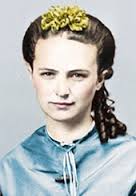Time to enter to win a copy of the book
None Wounded, None Missing, All Dead: The Story of Elizabeth Bacon Custer.
“Few living women can ride a horse equal to her and but few better.”
George Custer’s thoughts about Elizabeth’s equestrian skills – 1866
A group of mounted Union officers rode onto the crest of a barren hill overlooking Fort Riley, Kansas. Major Frederick Benteen was in the lead, his eyes were sharp as eagles and he searched out the vast country ahead with exceeding care. The military outpost the soldiers were riding towards in January 1867 was established to protect settlers and railroad workers from Indian attacks. Benteen and his division were going to reinforce that protection. He led troops in the battle against Cheyenne leader Black Kettle and his braves on the Washita River (near Cheyenne, Oklahoma) after the Civil War had ended. That experience convinced Benteen that he would be a major asset in the military’s quest to keep order on the expanding western frontier. “I struck the first blow in the Indian Wars…” he reminded his peers.
In addition to his involvement at the start of the Indian wars, Benteen openly agreed with his superior officer, General Phil Sheridan, who had been named administrator over the Great Plains after the War Between the States, that the best way to defeat the Indian would be to attack them during the winter months. The Plains Indians depended heavily on their warrior ponies that thrived primarily in the spring and summer. The ponies could easily outrun an Army horse and didn’t need saddles and shoes to do their job. They required very little sustenance either – no grain at all, just clumps of grass and very little water when it was available. The warrior ponies could also stand for hours without moving or neighing, which allowed its riders to sneak up on prey (deer, buffalo, etc.) easily. Winter was particularly hard on the animals because the ground was frozen. Finding any grass to eat under several layers of ice and snow was difficult. The ponies were generally skin-and-bones. Conversely, Army horses were sturdy during the winter, having fed on wholesome rations of grain. Soldiers could ride in on and Indian village, attack, and ride off with no fear of being followed.
Although Benteen shared his executive officer’s plan for when to engage the Indians in battle and also proved his considerable soldiering skills and dedication to the Union cause, General Sheridan made George Custer commander of the cavalry at Fort Riley. Benteen like many others resented George. He was one of the youngest decorated heroes of the Civil War, had attended West Point and rode thoroughbreds. Rumor had it he was conceited as a result of the accolades he had received and that Elizabeth was just as haughty. She too was educated and had mingled with presidents, senators, and generals. Benteen had not attended college and had a disdain for West Point graduates. His horse was not a pedigree, he had not been involved in combat, and his wife was not socially connected. Benteen believed answering to George would be difficult and supporting his staff a daily struggle, but orders had been given.


